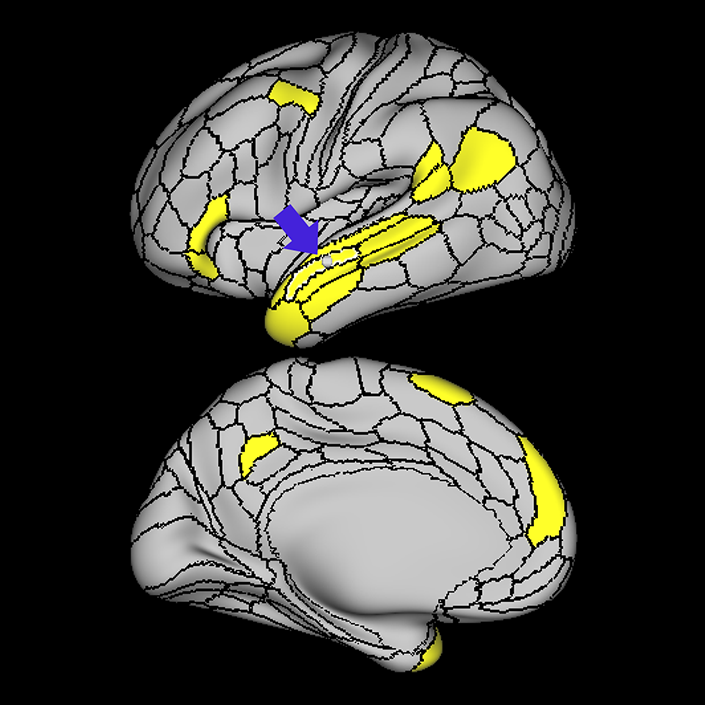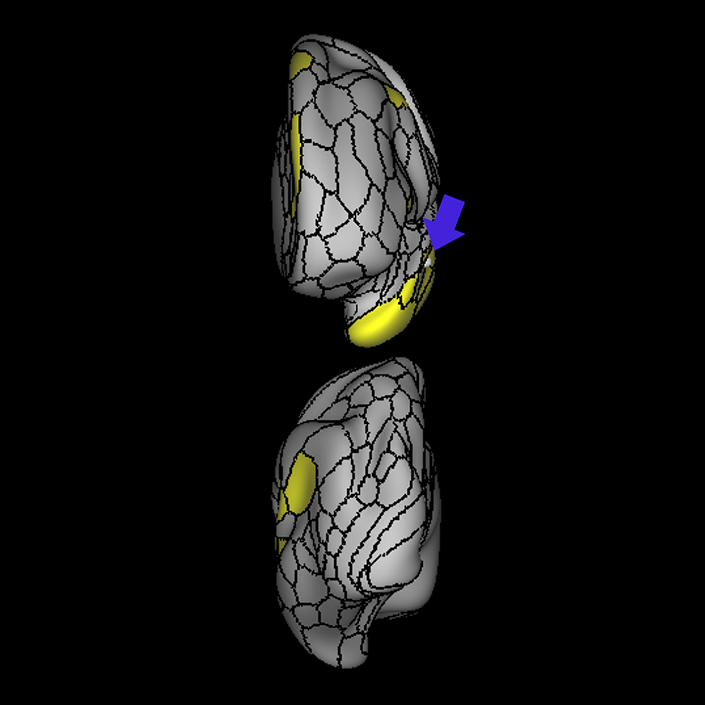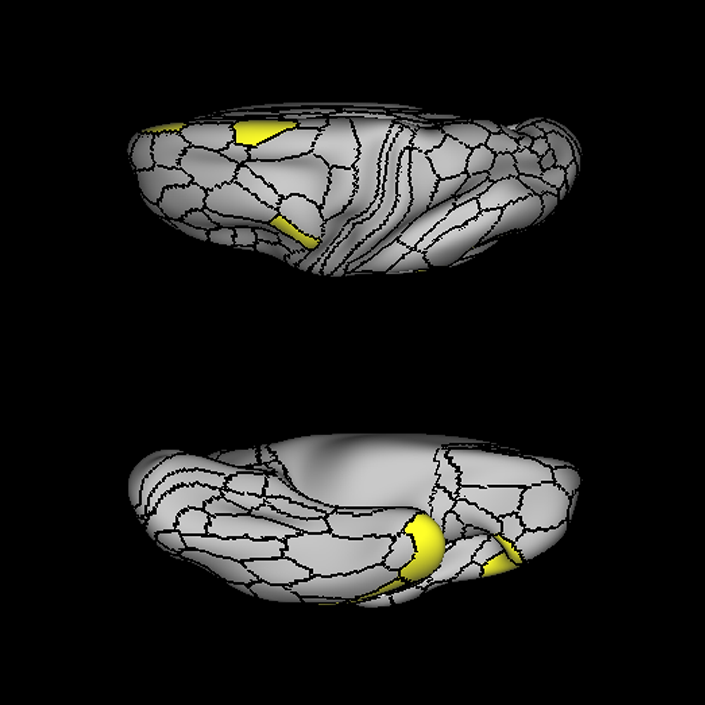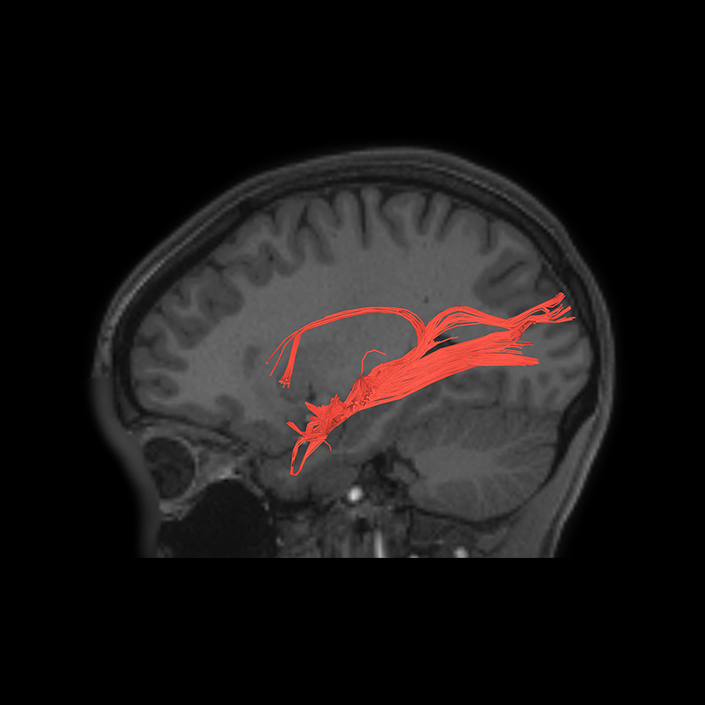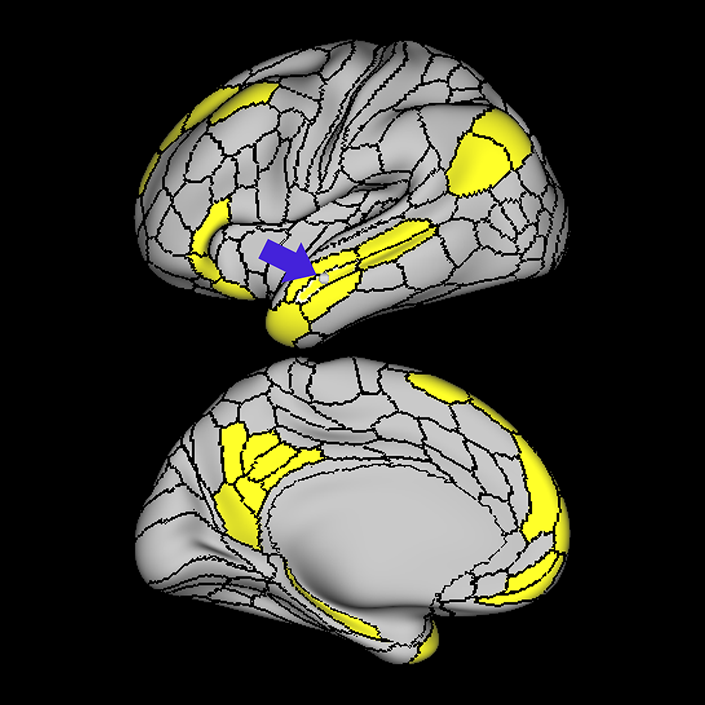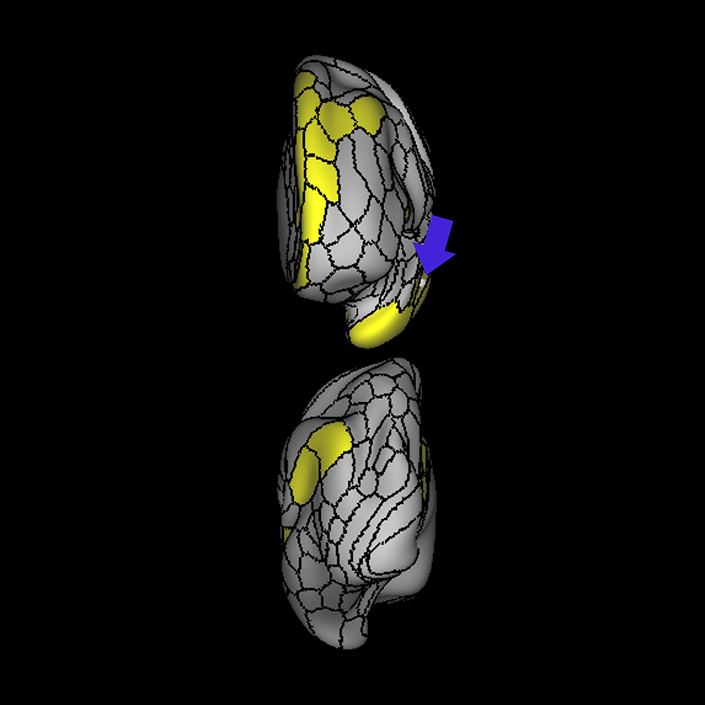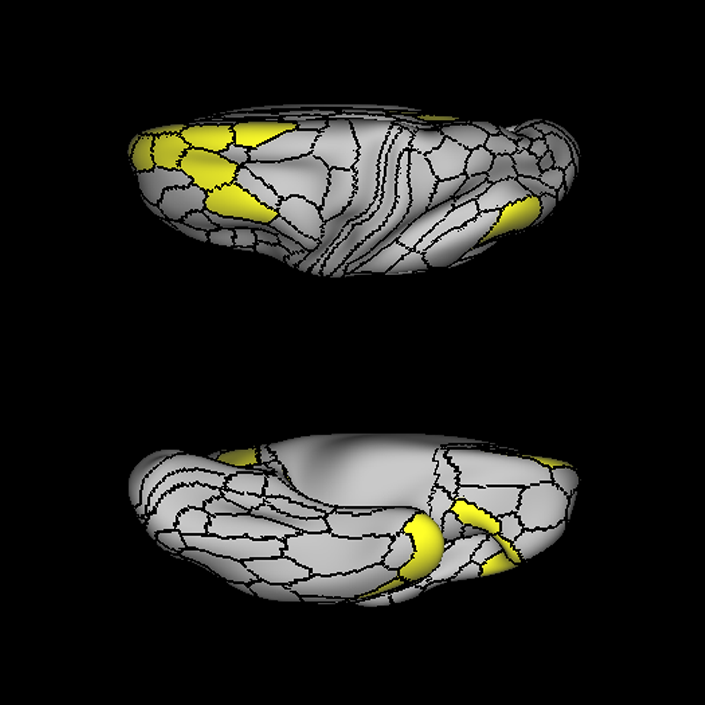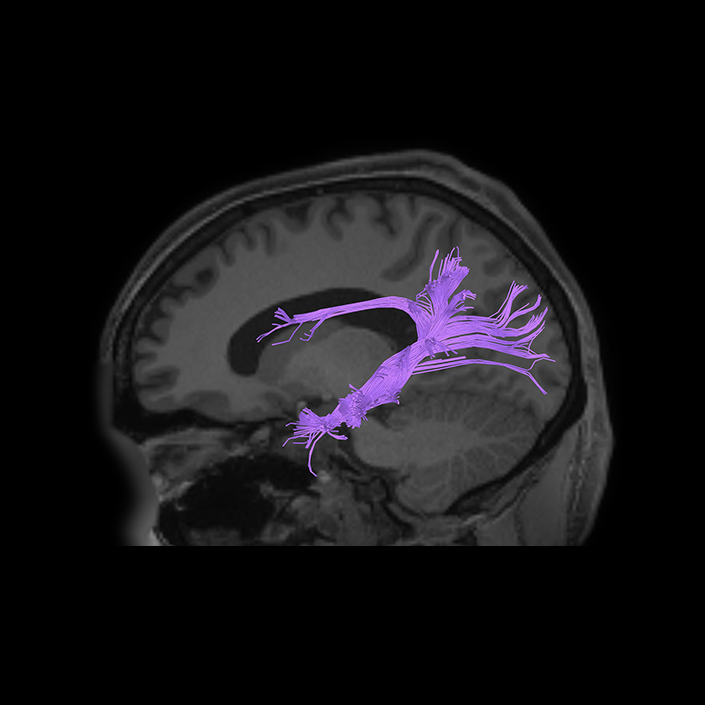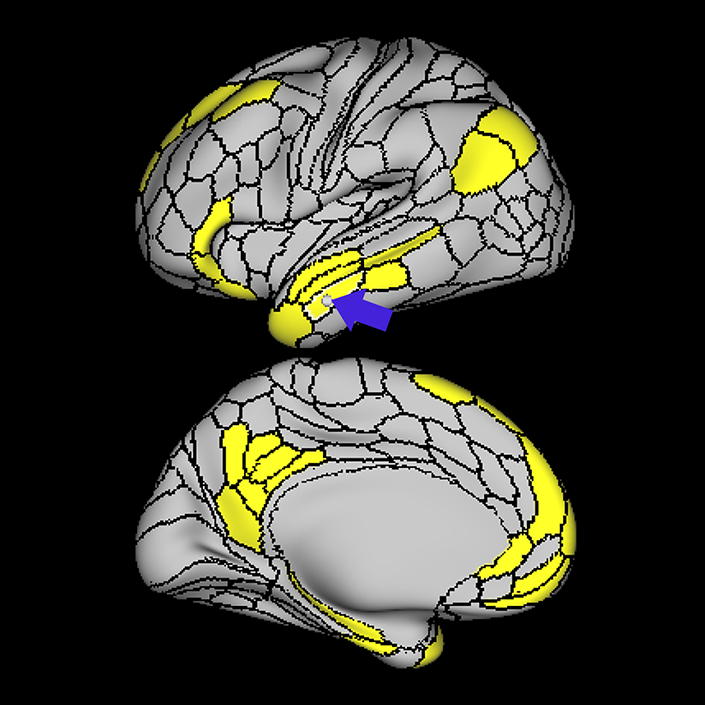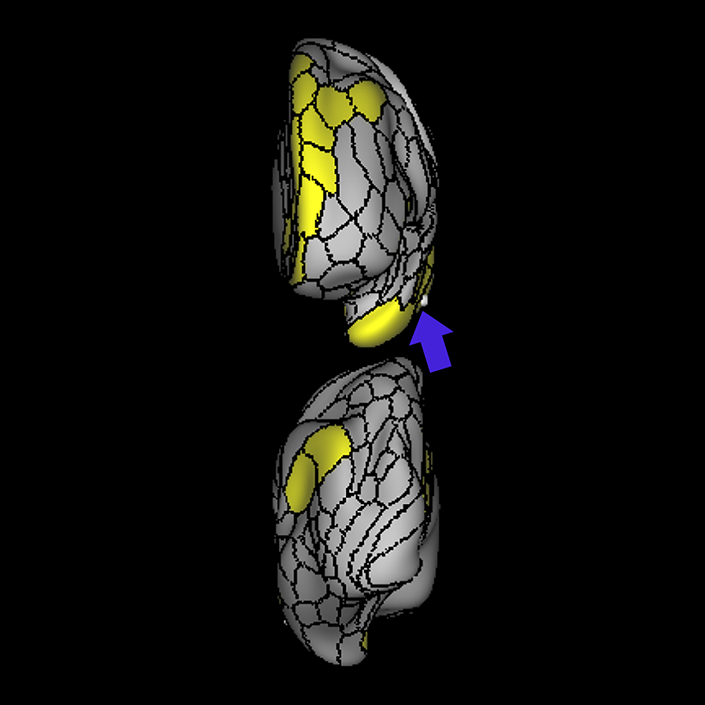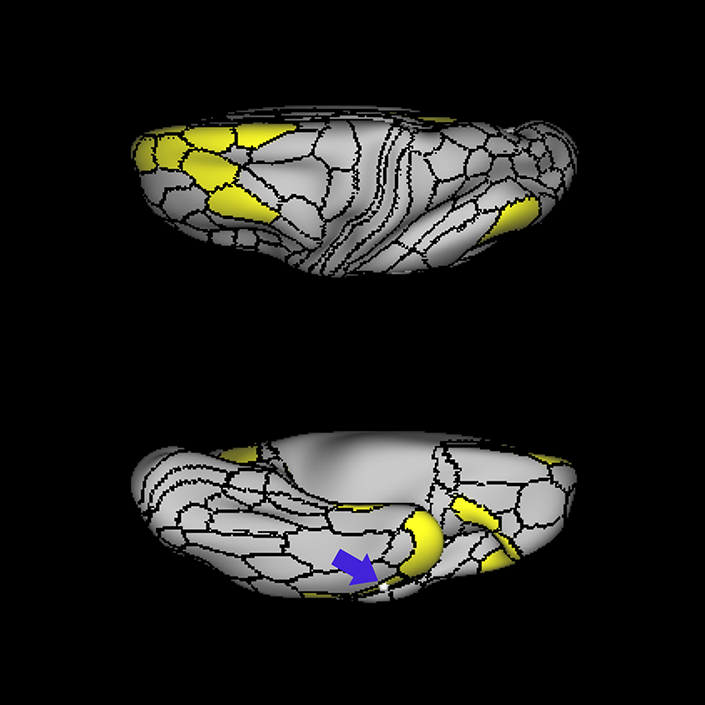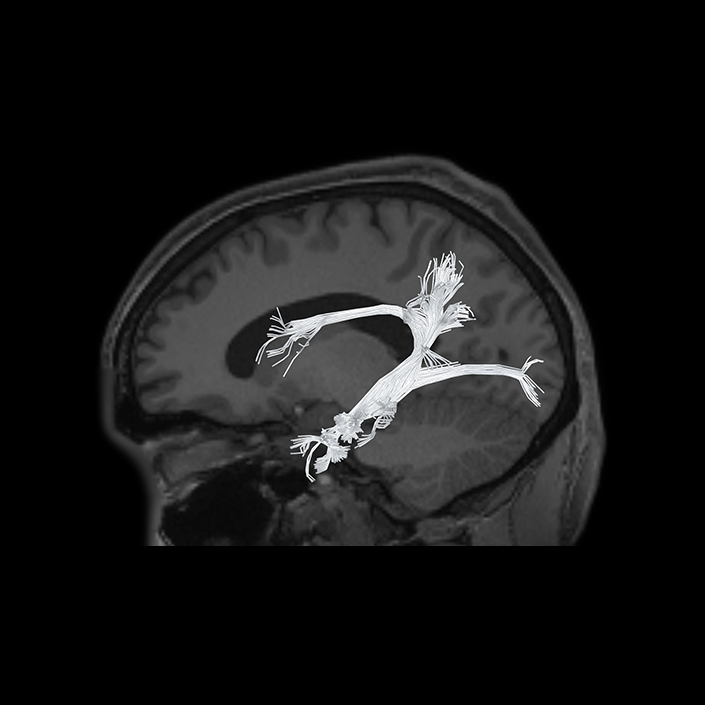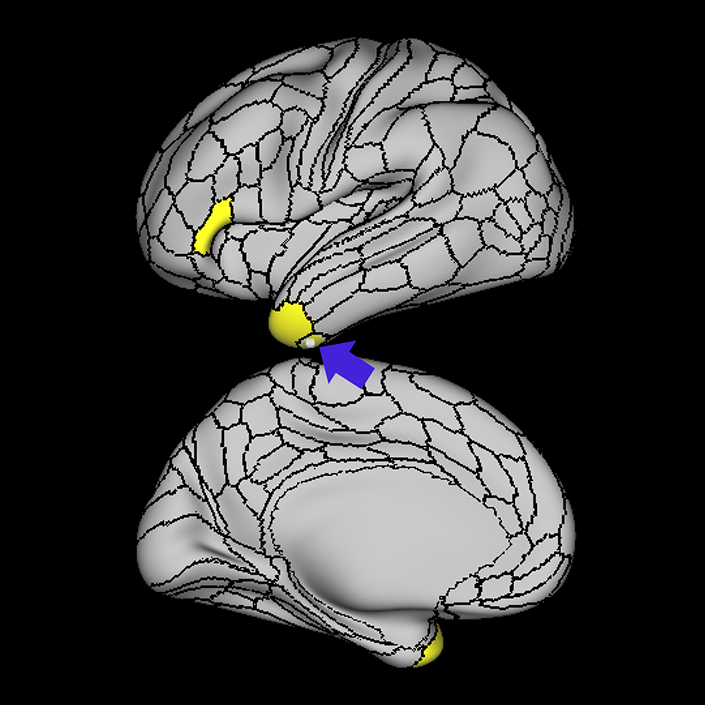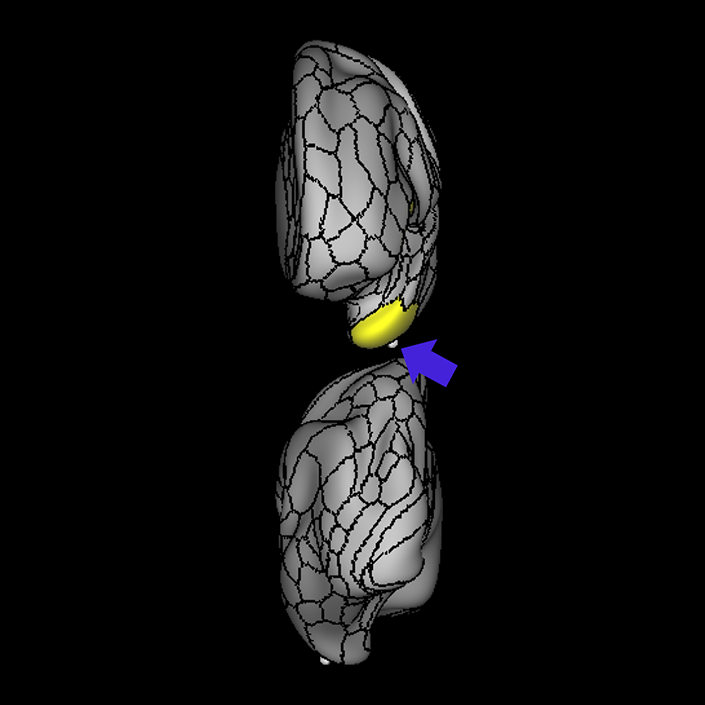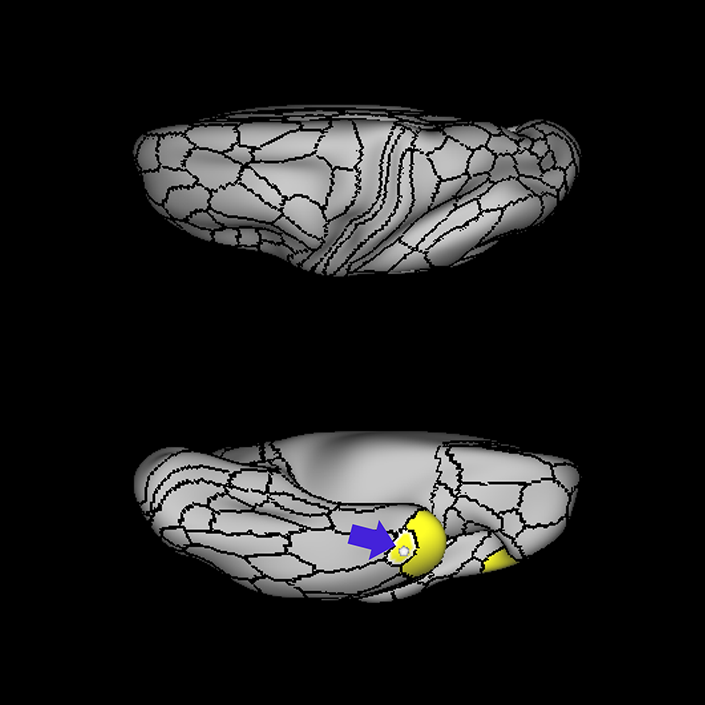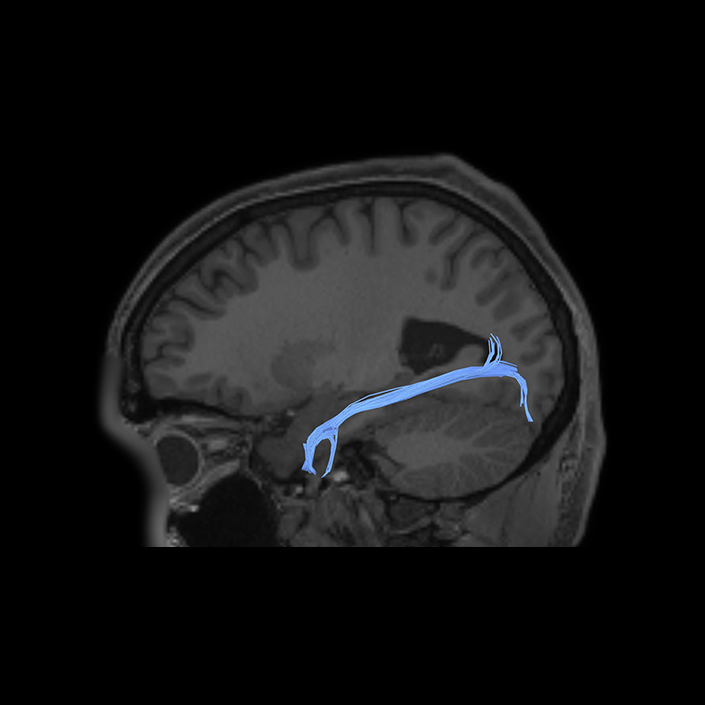ᐅ SummaryArea STSda (superior temporal sulcus dorsal anterior): part of the temporal lobe regions. Primarily implicated in speech processing. STSda is also activated in language-related task contrasts. Relative to STSva inferiorly, STSda shows greater activation in motor tasks and less deacti- vation in tasks involving reward processing and decision making. ᐅ Where is it?Area STSda (superior temporal sulcus dorsal anterior) is found on the anterior half of the lateral face of the STG and the anterior half of the superior bank of the superior temporal sulcus. ᐅ What are its borders?Area STSda borders area STSdp posteriorly, STSva and TGd inferiorly and anteroinferiorly, STGa anteriorly, and TA2 and A5 superiorly. ᐅ What are its functional connections?Area STSda demonstrates functional connectivity to areas 9m, 45, 47L, SFL and 55b in the frontal lobe, areas STV, PSL, A5, and STGa in the insula opercular area, areas STSva, STSvp, STSdp, TGd, and TE1a in the temporal lobe, and areas PGi and 31pd in the parietal lobe ᐅ What are its white matter connections?Area STSda is structurally connected to the arcuate/superior longitudinal fasciculus (SLF), middle longitudinal fasciculus (MdLF) and the "u" fibers of the occipito-temporal system. In some individuals, the STSda may also connect to the superior temporal terminations of inferior longitudinal fasciculus (ILF), though this is inconsistent across individuals and difficult to distinguish from the superior tracts of the MdLF. Arcuate/SLF tracts wrap around the Sylvian fissure projecting toward the frontal lobe and turn medially to terminate at FOP1, FOP3 and FOP4. MdLF tracts project through the temporal lobe to end at V1, V2, V3 and V4. Local short association fibers include "u" fibers of the occipito-temrporal system that connect to TGd, STSva and A5 ᐅ What is known about its function?The STS in general has been implicated in theory of mind along with the inferior temporal sulcus, medial prefrontal cortex, and temporal parietal junction. The STS is also involved in motion processing, speech processing, and facial processing. In addition to activating with unimodal visual and auditory inputs, the STS exhibits even stronger activation with combined audio and visual stimuli indicating a role in audiovisual integration. Based on activations during tasks involved with semantic processing of auditory inputs, STSda, STSva, STSdp, and STSvp may be categorized as belonging to an auditory association cortex with areas A4, A5, STGa, and TA2. STSda, as part of the anterior portion of the STS, is primarily implicated in speech processing. STSda is also activated in language-related task contrasts. Relative to STSva inferiorly, STSda shows greater activation in motor tasks and less deactivation in tasks involving reward processing and decision making. |
|
A: lateral-medial
B: anterior-posterior
C: superior-inferior
DTI image |
Connectome Guide
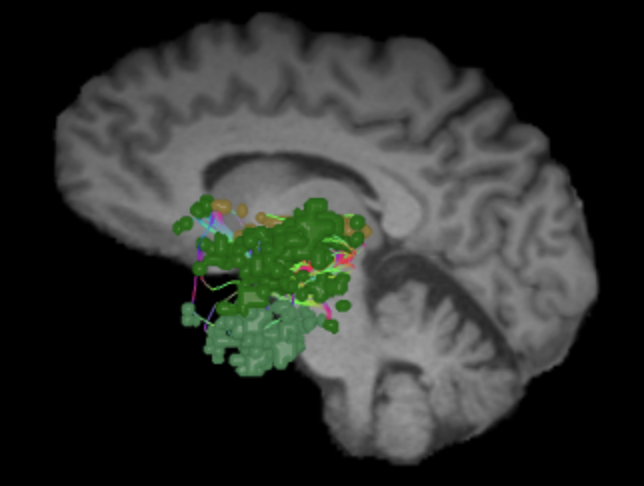
Accessory Language Network (ALN)
Why we think this network is worth considering in decision making:
The left temporal pole is increasingly recognized to play a key role in verbal memory, and surgical resection of the anterior temporal lobe on the left, which includes this network of middle temporal gyrus regions, can cause memory decline.
Evidence that this network is responsible for useful function in humans:
Xu et al (2015) have repeatedly shown that a portion of the extended default mode network extended along the middle temporal gyrus to the temporal pole. These areas have fMRI BOLD signal time courses, which are very correlated with the human language areas suggesting that they play a language role.1
The accessory language network encompasses subparts of STS, TE1 and TGv and involved in memory related components of language such as speech recognition and the representation of lexical concepts.2
Consequences of damage to this network:
Temporal Lobe epilepsy: Several studies reported impairments related to naming and recognition in verbal memory after temporal lobectomy.3,4 In other studies, it was also shown that in addition to naming, patients with anterior temporal lobectomies had difficulty with identifying famous faces.5,6
Semantic dementia: Semantic dementia associated with progressive aphasia is also shown to be related focal degeneration in the temporal regions.7 Further studies confirmed the findings of the original work by Mesulam and found abnormal metabolic function and structural changes in this region in patients with semantic dementia.8,9,10
ᐅ SummaryArea STSva (superior temporal sulcus ventral anterior): part of the temporal lobe regions. Primarily implicated in speech processing. Activated in the story-math contrast as well as in primary language tasks. Relative to STSda inferiorly, STSva is less activated in motor tasks and more deactivated in tasks involved with reward processing and decision making. ᐅ Where is it?Area STSva (superior temporal sulcus ventral anterior) is found on the anterior half of the inferior bank of the superior temporal sulcus ᐅ What are its borders?Area STSva borders area STSvp posteriorly, TGd anteriorly, TE1a inferiorly, and STSda superiorly. ᐅ What are its functional connections?Area STSva is connected to 8AV, 8BL, 8AD, 9a, 9p, 9m, 45, 47s, 47L, 10d, 10r, 10v, and SFL in the frontal lobe, areas STSda, STSvp, STSdp, TGd, the hippocampus, and TE1a in the temporal lobe, and areas PGi, 7m, d23ab, 23d, 31pv, and 31pd in the parietal lobe ᐅ What are its white matter connections?Area STSva is structurally connected to the MdLF, "u" fibers of the occipito-temporal system and the arcuate/SLF. Arcuate/SLF tracts wrap around the Sylvian fissure projecting toward the frontal lobe and turn medially to terminate at 44, IFJa, 6r and 43. MdLF fibers course through the temporal lobe to end at V1, V2, V3, V4 and V3a. This tract may involve superior portions of the ILF. Local short association fibers include "u" fibers of the occipito-temrporal system that connect to STSda, STSdp, STSvp, PSL, PFm and PF ᐅ What is known about its function?As part of the anterior portion of the STS, STSva is primarily implicated in speech processing. STSda is activated in the story-math contrast as well as in primary language tasks. Relative to STSda inferiorly, STSva is less activated in motor tasks and more deactivated in tasks involved with reward processing and decision making. |
|
A: lateral-medial
B: anterior-posterior
C: superior-inferior
DTI image |
ᐅ SummaryArea TE1a (temporal area 1 anterior): part of the temporal lobe regions. Appears to break the functional pattern found in the literature as it is more active in semantic pathways than visual pathways. TE1a is deactivated rather than activated during tasks requiring recognition of relationships between visual objects, visual working memory tasks, and motor activity tasks. In contrast, relative to TE1m, TE1a shows greater activation in language processing tasks. ᐅ Where is it?Area TE1a (TE 1 anterior) is found on the anterior 1/3 of the lateral face of the middle temporal gyrus up to the edge of the inferior temporal sulcus. ᐅ What are its borders?Area TE1a borders STSva superiorly, TGd anteriorly, TE2a inferiorly, and TE1m posteriorly. ᐅ What are its functional connections?Area TE1a demonstrates functional connectivity to 8AV, 8AD, 8BL, 9a, 9p, 9m, a24, 45, 47s, 47L, 10d, 10v, 10r, and SFL in the frontal lobe, areas STSva, STSvp, STSda, TGv, EC, the hippocampus, and TE1m in the temporal lobe, and areas PGs, PGi, 7m, d23ab, 31pv, and 31pd in the parietal lobe ᐅ What are its white matter connections?Area TE1a is structurally connected to the arcuate/SLF, "u" fibers of the occipito-temporal system and the ILF. Arcuate/SLF tracts wrap around the Sylvian fissure projecting toward the frontal lobe to turn medially and terminate at 44, FOP4 and FOP3. There are posterior projections from the arcuate/SLF as it wraps around the Sylvian fissure to terminate at the inferior parietal lobule at PFm, PF, PSL and STV. The ILF courses through the inferior temporal lobe to terminate at V1 and V2. Local short association fibers include "u" fibers of the occipito-temrporal system that connect to STSva, STSvp and TE1m White matter tracts of TE1a in the right hemisphere have more consistent connections with the MdLF. ᐅ What is known about its function?The inferior temporal area (TE) is thought to be the final stage of the ventral visual processing pathway, and therefore is likely responsible for processing and representing information about complex visual objects. TE is also important for short term maintenance of visual object information as part of working memory. Both TE1 and TE2 are thought to be primarily unimodal visual areas and not heavily involved with processing of audio or somatosensory inputs. TE1a appears to break this functional pattern found in the literature because it is more active in semantic pathways than visual pathways. TE1a is deactivated rather than activated during tasks requiring recognition of relationships between visual objects, visual working memory tasks, and motor activity tasks. In contrast, relative to TE1m, TE1a shows greater activation in language processing tasks. |
|
A: lateral-medial
B: anterior-posterior
C: superior-inferior
DTI image |
ᐅ SummaryArea TGv (temporal area g ventral): part of the temporal lobe regions. Areas TGv and TGd make up the temporal polar cortex described in the previous section. Area TGv, like TGd, is activated in language-related task contrasts suggesting a role in ventral stream language processing. Compared to TGd superiorly, TGv is activated vs deactivated in motor tasks in response to a visual cue and relational primary contrasts (ie, distinguishing objects based on feature dimensions). ᐅ Where is it?Area TGv (TG ventral) is found on the inferior temporal polar region just anterior to the ITG and fusiform gyrus. ᐅ What are its borders?Area TGv borders TE2a posteriorly on its lateral surface, TF posteriorly on its basal surface, and TGd superiorly. PeEc makes up its medial basal surface. ᐅ What are its functional connections?Area TGv demonstrates functional connectivity to areas 45 and TGd. ᐅ What are its white matter connections?Area TGv is structurally connected to the ILF. ILF projections travel through the inferior temporal lobe to terminate at V1, V2, V3 and V4 ᐅ What is known about its function?Areas TGv and TGd make up the temporal polar cortex described in the previous section. Area TGv, like TGd, is activated in language-related task contrasts contrasts suggesting a role in ventral stream language processing. Compared to TGd superiorly, TGv is activated vs deactivated in motor tasks in response to a visual cue and relational primary contrasts (i.e. distinguishing objects based on feature dimensions) |
|
A: lateral-medial
B: anterior-posterior
C: superior-inferior
DTI image |
Reference list
- Xu J, Wang J, Fan L, Li H, Zhang W, Hu, Q., & Jiang, T. (2015). Tractography-based Parcellation of the Human Middle Temporal Gyrus. Scientific Reports, 2015;5, 18883. https://doi.org/10.1038/srep18883
- Chang F, Raygor P, Berger S. Contemporary model of language organization: An overview for neurosurgeons. In Journal of Neurosurgery 2015;122(2), 250-261. American Association of Neurological Surgeons. https://doi.org/10.3171/2014.10.JNS132647
- Drane L, Ojemann A, Aylward E, Ojemann G, Johnson C, Silbergeld L, Miller W, Tranel D. Category-specific naming and recognition deficits in temporal lobe epilepsy surgical patients. Neuropsychologia, 2008;46(5), 1242–1255. https://doi.org/10.1016/j.neuropsychologia.2007.11.034
- Saykin J, Stafiniak P, Robinson J, Flannery A, Gur C, O’Connor J, Sperling R. Language Before and After Temporal Lobectomy: Specificity of Acute Changes and Relation to Early Risk Factors. Epilepsia, 1995;36(11), 1071–1077. https://doi.org/10.1111/j.1528-1157.1995.tb00464.x
- Drane L, Ojemann G, Phatak V, Loring W, Gross E, Hebb O, Silbergeld L, Miller W, Voets L, Saindane M, Barsalou L, Meador J, Ojemann A, Tranel D. Famous face identification in temporal lobe epilepsy: Support for a multimodal integration model of semantic memory. Cortex, 2013;49(6), 1648–1667. https://doi.org/10.1016/j.cortex.2012.08.009
- Glosser G, Salvucci E, Chiaravalloti D. Naming and recognizing famous faces in temporal lobe epilepsy. Neurology, 2013;61(1), 81–86. https://doi.org/10.1212/01.WNL.0000073621.18013.E1
- Mesulam M. Slowly progressive aphasia without generalized dementia. Annals of Neurology, 1982;11(6), 592–598. https://doi.org/10.1002/ana.410110607
- Chawluk B, Mesulam M, Hurtig H, Kushner M, Weintraub S, Saykin A, Rubin N, Alavi A, Reivich M. Slowly progressive aphasia without generalized dementia: Studies with positron emission tomography. Annals of Neurology, 1986;19(1), 68–74. https://doi.org/10.1002/ana.410190112
- Czarnecki K, Duffy R, Nehl R, Cross A, Molano R, Jack R, Shiung M, Josephs A, Boeve F. Very early semantic dementia with progressive temporal lobe atrophy an 8-year longitudinal study. Archives of Neurology, 2008;65(12), 1659–1663. https://doi.org/10.1001/archneurol.2008.507
- Landin-Romero R, Tan R, Hodges R, Kumfor F. An update on semantic dementia: Genetics, imaging, and pathology. In Alzheimer’s Research and Therapy 2016;8(1). BioMed Central Ltd. https://doi.org/10.1186/s13195-016-0219-5
